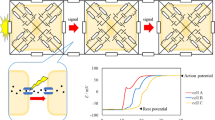Abstract
The whole-cell recording technique was used to investigate the actions of a calcium release channel ligand, ryanodine, on calcium-activated chloride conductances, and to evaluate ryanodine-sensitive Ca2+-induced Ca2+ release from intracellular stores in cultured neonatal rat DRG neurones. The aim of the project was to use ryanodine as a pharmacological tool to evaluate calcium-induced calcium release in the cell bodies of cultured DRG neurones. Action potential after-depolarizations were attenuated by extracellular application of the chloride channel blocker, niflumic acid (10 µM), and by ryanodine (10 µM); these actions occurred without concurrent changes in evoked action potentials. Ryanodine and caffeine (10 mM) activated calcium-dependent conductances and the responses to ryanodine were attenuated by depletion of caffeine-sensitive Ca2+ stores. The current clamp data were complicated by changes in potassium conductances so studies were carried out under voltage clamp and voltage-activated calcium currents and calcium-activated chloride and non-selective cation currents were isolated pharmacologically. Ryanodine (10 µM) evoked delayed, inward, calcium-activated non-selective cation and chloride currents which reversed close to 0 mV and were attenuated by N-methyl-d-glucamine, niflumic acid and dantrolene. Consistent with actions on action potential after-depolarizations, niflumic acid (10 µM) and ryanodine (10 µM) attenuated calcium-activated chloride currents evoked by calcium entry through voltage-activated calcium channels. Niflumic acid and ryanodine had no effects on voltage-activated calcium currents evoked from a holding potential of –90 mV by voltage step commands to 0 mV. In conclusion calcium-activated chloride conductances appear to be activated in part by calcium released from ryanodine-sensitive stores, and significant calcium-induced calcium release may occur locally in cell bodies of DRG neurones as a result of calcium entry through voltage-activated channels during an action potential.
Similar content being viewed by others
Author information
Authors and Affiliations
Additional information
Received: 6 July 1998 / Accepted: 30 November 1998
Rights and permissions
About this article
Cite this article
Ayar, A., Scott, R. The actions of ryanodine on Ca2+-activated conductances in rat cultured DRG neurones; evidence for Ca2+-induced Ca2+ release. Naunyn-Schmiedeberg's Arch Pharmacol 359, 81–91 (1999). https://doi.org/10.1007/PL00005335
Issue Date:
DOI: https://doi.org/10.1007/PL00005335




